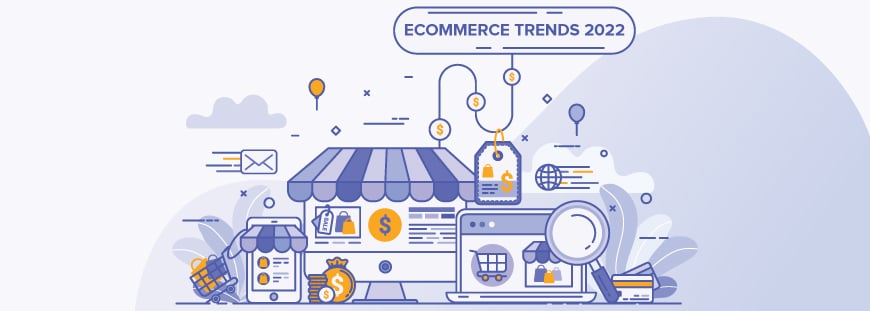7 Top Ecommerce Trends for 2022
2021 was all about digital transformation but 2022 is going to be more about differentiation and providing fully-customized services for customers. Living up to customer expectations is not an easy task but ITG’s mission is to provide cutting edge solutions. In this article we have collected 7 trends that will define 2022 and keep you prepared and one step ahead of the game!
1. Chatbots & Conversational Shopping
Successfully guiding website visitors is a legitimate need. When potential customers have questions – about products or where to find something on your site, they expect an immediate answer or will leave before investing too much of their valuable time.
There are 2 options to meet this expectation: #1 employ multiple colleagues with various language skills (costly option, worse) or #2 implement a chatbot solution to answer queries in real time (cost-efficient option, better). In 2022, we are focused on chatbot solutions to solve real time communication requirements. Chatbots should not be limited to your website but should also be deployed on other channels like Facebook Messenger and / or voice technologies like Alexa and Siri to serve hard won visitors the way they expect to be treated.
2. Augmented & Virtual Reality
In 2022 the primary goal is recreating the offline retail experience online to meet customers subconscious expectations for the same. This applies to B2B companies too as today’s B2B customers have become accustomed to the online B2C customer experience for many years already. As before, chatbots can, to some extent, replace employees and provide customer guidance but how to replace the product ‘touch and feel’ element from a traditional offline retail experience?
Product visualizers, product builders, 3D mapping and augmented reality are critical to bridging the gap between the on and offline experience. Via standard smart phone technology, your potential customers can make products come alive in their living room or kitchen by observing how items might fit into the current layout. Or how new shoes might look on customer feet through the screen of their phone. Sounds cutting edge but these solutions are more practical than you might think and a game changing edge against the competition.
3.Diverse Payment & Delivery Methods
Customers want to pay and receive things immediately and with minimal effort. The growing tendency is integrating credit cards with phones to “pay without pain” allowing folks to spend more conveniently. Supporting 1-click payment methods is essential as, once users get a sense of the convenience, they are unlikely to revert back to bank transfers or any of the ‘old ways’ again.
Home delivery is still a global trend in 2022, but it is no longer enough to deliver products within a few days. Users prefer same day delivery if the option exists. More and more companies offer this possibility, so better to implement this feature before the competition does.
4. Social Commerce & Marketplaces
More and more buyers use social media to browse for new products and / or to follow favorite brands. That is why companies are increasingly selling items directly from where shoppers spend the majority of their time, social media. Toward this global trend, social commerce sales are projected to reach $79.6 billion in 2025. Rather than focusing strictly on their webshops, companies are choosing a variety of other channels to as revenue generators. Selling on Amazon or employing product feeds to appear on other partners websites and marketplaces really do help to increase sales and profits.
5. Omnichannel Customer Experience
Most online shoppers use multiple channels to purchase online so an omnichannel approach is required to meet current expectations. But what is an omnichannel approach and how to differentiate that from a multichannel one?The primary difference is that a multichannel approach is mostly about offering multiple channels for customers to get in contact whereas the omnichannel experience is about aligning all channels to where users are in their customer journey. For example, if a user buys jeans offline with a club card, online ads can show up on their mobile phone about the shirt or shoes that might perfectly complement the jeans purchased. With this approach everything can be connected., subsequently showing your customers that you value their time and understand their needs.
6. Sustainability & Responsibility
Sustainability is not strictly about being eco-friendly but about being purpose-driven too. Eco-friendliness is important because customers value the emotions around contributing toward saving the planet. Customers value every step of the journey, like transitioning away from plastics or reducing harmful substances toward that goal. Besides contributing to sustainability directly, companies can help indirectly by informing their customers about carbon footprint (like MasterCard) or by donating to sustainability-focused organizations. This alignment builds trust and drives growth for your business too.
7. Cloud adoption & Headless technology
Adopting cloud hosting will be a top priority for many companies in 2022. Creating a competitive advantage will greatly depend how well you can execute and manage cloud hosting. Further, headless technologies, i.e., the frontend of the website is separated from the backend, will bring more flexibility, more integration and less siloed solutions to market and make it easier to keep up with quickly evolving user interface trends.
Wrapping up
The trends emerging in 2022 are focused on adaptation, personalization and living up to customer expectations with the help of Augmented Reality, Virtual Reality and Machine Learning toolsets. To set proper expectations, remember that future success depends on the flexibility and willingness to learn, adapt and embrace these change.
If you are looking for a partner to help you with this transformation, please reach out with any questions you might have. Check out our services or schedule a call . We are looking forward to meeting you.

In his role as ITG Commerce Product Owner, Mark brings seven years of leadership experience in various IT and marketing projects.

